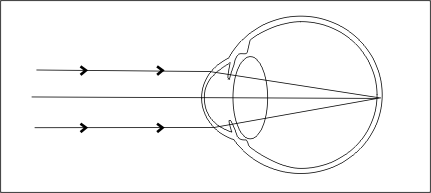Visual perception depends greatly on the quality of the image formed on the retina. Several diseases and deformities of the eye can affect the quality of this image. Humans need two eyes to perceive a three-dimensional perspective, or stereoscopic vision. Two images are formed on the retina and the slight shift between them allows the cerebrum to construct a three-dimensional image and to evaluate the distance of objects.
When the eye focuses the light rays on the retina, the image is sharp and the eye is said to be in the state of emmetropia. This is the optimal situation for an eye which, in this case, can be considered free of defects.
Myopia, also called nearsightedness, makes distant objects blurry, as the image is formed in front of the retina. Myopia can be caused by two phenomena. It can be due to a slightly elongated eyeball, which is mostly hereditary, or due to an overly curved lens, which can be linked to bad visual habits such as reading too closely or in dim lighting. In both situations, the light rays converge before they reach the retina. This problem is usually corrected with concave lenses which slightly diverge the light before it enters the lens of the eye. With this adjustment, the light rays converge on the retina to provide a clear image.

There are two abnormalities that cause some people to see well at a distance but blurry up close. These disorders cause light rays to converge behind the retina. The first of these is hyperopia, also called hypermetropia or farsightedness, caused by the eyeball being slightly too short or having an insufficiently curved lens. This disorder is usually hereditary. The second disorder is presbyopia and has the same effect as hyperopia. This is caused by the aging of the eye, which makes the lens less flexible and difficult to adjust for a sharp image. Both of these problems are corrected with biconvex lenses which converge the light rays on the retina.

An astigmatism causes impaired vision with both distant and near objects. This visual disorder is caused by irregularities in the curvature of the cornea or the lens. Light rays that pass through the transparent media disperse in different directions. This problem can be corrected by wearing cylindrical lenses that focus the light rays, limiting deviation.
Other vision disorders
Diplopia, or double vision, is a disorder that impairs stereoscopic vision by producing two images rather than one for the same visual field. The problem lies in the lack of coordination between the muscles of each eyeball. It can be caused by paralysis, congenital muscle weakness or a state of drunkenness (which affects vision temporarily).
Strabismus, or crossed eyes, is a congenital weakness in the parallelism of the eyes. In other words, the two eyes are not oriented in the same direction. The brain compensates either by staring alternately with each eye or by ignoring the signal from the deficient eye. Surgery is performed in more severe cases.
Retinal detachment is another vision disorder that often causes blindness. When it occurs, the photoreceptors in the retina are separated from the nerve endings that transmit the signal. Retinal detachment is usually caused by a severe blow to the head, infiltration of the vitreous between the retina and the choroid or due to a tumour, aging or vascular disease. If diagnosed early, it can be corrected with laser surgery.
Glaucoma is caused by a drainage disorder of the vitreous fluid, which increases the internal pressure. The vitreous fluid compresses the retina and the optic nerve, causing blindness. People over forty should have an annual check-up to detect this disease in its early stages and avoid the worst outcome.
Cataracts are caused by clouding of the lens. Most of them occur as a result of hardening and thickening of the lens. This is due to a lack of nutrient supply to the deep fibres of the lens. Risk factors for cataracts include smoking, congenital disease and frequent exposure to the sun. This disease can be treated by surgically removing the lens and replacing it with an artificial lens.
